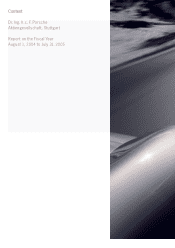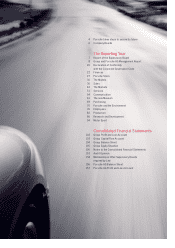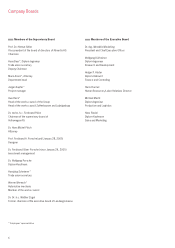Porsche 2004 Annual Report Download - page 15
Download and view the complete annual report
Please find page 15 of the 2004 Porsche annual report below. You can navigate through the pages in the report by either clicking on the pages listed below, or by using the keyword search tool below to find specific information within the annual report.
11
The 17.4 percent growth in 911 sales to 27,826 units was most
impressive. The new generation of this classic model was introduced
successively to world markets from July 2004 on, starting with the
911 Carrera Coupe und 911 Carrera S Coupe.The Cabriolet soft-top
versions followed later, starting in the spring of 2005. During the
reporting year, about 27 percent of all 911 buyers chose a Cabrio-
let version. The S versions of the 911 Carrera Coupe and Cabriolet,
with even more powerful engines, were also extremely popular:
68 percent of 911 buyers chose them instead of the basic model.
Until the early summer of 2005, certain versions of the previous mo-
del were still being built in parallel with the new-generation 911 models.
Of these, demand was highest for the Carrera 4 S Cabriolet and the
Turbo Cabriolet. The new-generation 911 model line will gradually
be completed by introducing further versions: for example, the latest
all-wheel-drive versions reached the market in October 2005.
The latest Boxster model generation was introduced in successive
stages to international markets from the end of 2004 on. Although
the roadster segment remains fiercely contended, it proved possible
to boost sales of the Boxster considerably, which is evidence of the
additional appeal that the latest model possesses. During the re-
porting year, 18,009 were sold, an increase of 38.7 percent. The
more powerful Boxster S version accounted for 8,261 units, a
45.9 percent share of total Boxster sales volume. In the previous year
the proportion had been 49.6 percent, but the total also included the
special “550 Spyder 50th Anniversary” version of the Boxster S. In
the current fiscal year the Boxster model line has been upgraded
still further by the introduction in November 2005 of the Cayman S,
a Boxster-based but independent sport coupe.
Including the Carrera GT, of which 660 were sold (previous year: 222),
the Porsche Group sold a total of 88,379 vehicles in the 2004/05
fiscal year, a 15 percent increase on the 76,827 units sold in the
same period a year previously. In other words, there was no inter-
ruption in Porsche’s growth course.
In the reporting year, Group sales were again well below the total
number of vehicles built. The main reason for this is that vehicles
used by the Porsche Group for its own purposes are not listed as new
car sales. This category includes company cars driven by or leased
to employees, experimental vehicles, vehicles operated for the com-
pany’s own purposes, test vehicles for journalists and vehicles loaned
temporarily by the Group’s own sales subsidiaries and its dealers
when customers’ own cars are off the road. These vehicles are in all
cases sold as pre-owned and therefore appear in the Porsche Group’s
sales revenues and earnings.
Strong Demand worldwide
During the reporting year, the demand for Porsche vehicles remain-
ed strong in all parts of the world. North America was once again
the largest sales region, though the overall growth dynamic was
stronger in other export markets. This was due in particular to the
Cayenne, which achieved strong sales growth in markets where the
company’s presence with its sports cars has so far been only slight,
for example in the Middle East. On European markets such as Spain
and Italy, however, Porsche was also able to sell distinctly more
cars in the reporting year than in the previous year. Total sales in all
export markets except for North America were 40,334 vehicles, an
increase of 21.1 percent compared with the previous year’s figure
of 33,295 vehicles. In North America, sales went up by 8.9 percent
to 34,143 vehicles (previous year: 31,356). Although Cayenne sales
were slightly weaker in the reporting year, at 16,691 units (three per-
cent down), the sport utility vehicle remained the top-selling Porsche
model. Sales of the 911 and Boxster sports cars went up noticeably
to 17,040 cars (21.4 percent more). Carrera GT sales in North
America totaled 412 cars (previous year: 99).
Although the domestic scene remained generally weak, Porsche
once again sold more cars on the German market than in the pre-
vious year. An increase of 14.2 percent to 13,902 cars was recor-
ded, the lion’s share being accounted for by the Cayenne, sales of
which went up by 5.7 percent to 5,543 units. The latest 911 and
Boxster model generations established themselves well: together,
these two sports car model lines sold 8,290 units, an increase of
























